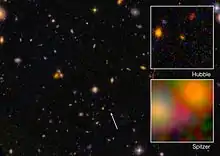EGSY8p7
EGSY8p7 (EGSY-2008532660) is a distant galaxy in the constellation of Boötes, with a spectroscopic redshift of z = 8.68 (photometric redshift 8.57), a light travel distance of 13.2 billion light-years from Earth. Therefore, at an age of 13.2 billion years, it is observed as it existed 570 million years after the Big Bang, which occurred 13.8 billion years ago, using the W. M. Keck Observatory.[4] In July 2015, EGSY8p7 was announced as the oldest and most-distant known object, surpassing the previous record holder, EGS-zs8-1, which was determined in May 2015 as the oldest and most distant object. In March 2016, Pascal Oesch, one of the discoverers of EGSY8p7, announced the discovery of GN-z11, an older and more distant galaxy.[5]
| EGSY8p7 EGSY-2008532660 | |
|---|---|
 | |
| Observation data (J2000 epoch) | |
| Constellation | Boötes |
| Right ascension | 14h 20m 08.50s |
| Declination | +52° 53′ 26.60″ |
| Redshift | 8.683+0.001 −0.004[1] |
| Heliocentric radial velocity | 2,603,098 km/s (1,617,490 mi/s) |
| Galactocentric velocity | 2,603,221 km/s (1,617,567 mi/s) |
| Distance | 13.2 billion ly (4.0 billion pc) (light travel distance) 30.5 billion ly (9.4 billion pc) (comoving distance) |
| Apparent magnitude (V) | 25.3 |
| Other designations | |
| EGSY8p7,[2] EGS8p7[3] | |
The galaxy contains a supermassive black hole, the CEERS 1019 black hole.
Detection
The light of the EGSY8p7 galaxy appears to have been magnified twofold by gravitational lensing in the light's travel to Earth, enabling the detection of EGSY8p7, which would not have been possible without the magnification. EGSY8p7's distance from Earth was determined by measuring the redshift of Lyman-alpha emissions. EGSY8p7 is the most distant known detection of hydrogen's Lyman-alpha emissions. The distance of this detection was surprising, because neutral hydrogen (atomic hydrogen) clouds filling the early universe should have absorbed these emissions, even by some hydrogen cloud sources closer to Earth, according to the standard cosmological model. A possible explanation for the detection would be that reionization progressed in a "patchy" manner, rather than homogeneously throughout the universe, creating patches where the EGSY8p7 hydrogen Lyman-alpha emissions could travel to Earth, because there were no neutral hydrogen clouds to absorb the emissions.[6][2][7][3][8]
See also
- GN-z11 (z=11.1)
- MACS0647-JD (z=10.7)
- UDFy-38135539 (z=8.55)
- EGS-zs8-1 (z=7.73)
References
- Adi Zitrin; Ivo Labbe; Sirio Belli; Rychard Bouwens; Richard S. Ellis; Guido Roberts-Borsani; Daniel P. Stark; Pascal A. Oesch; Renske Smit (2015). "Lyman-alpha Emission from a Luminous z = 8.68 Galaxy: Implications for Galaxies as Tracers of Cosmic Reionization". The Astrophysical Journal. 810 (1): L12. arXiv:1507.02679. Bibcode:2015ApJ...810L..12Z. doi:10.1088/2041-8205/810/1/L12. S2CID 11524667.
- "A new record: Keck Observatory measures most distant galaxy". Astronomy Now. 6 August 2015.
- Pyle, Rod (3 September 2015). "Farthest Galaxy Detected". Caltech.
- "New Record: Keck Observatory Measures Most Distant Galaxy". W. M. Keck Observatory. Archived from the original on 15 August 2015. Retrieved 12 January 2022.
- Amos, Jonathan (March 3, 2016). "Hubble sets new cosmic distance record". BBC News. Retrieved March 3, 2016.
- Wall, Mike (5 August 2015). "Ancient Galaxy Is Most Distant Ever Found". Space.com.
- Winkler, Mario De Leo (15 July 2015). "The Farthest Object in the Universe". Huffington Post.
- "Farthest Galaxy Detected". Caltech. 3 September 2015. Retrieved 2015-09-08.
External links
- "New Record: Keck Observatory Measures Most Distant Galaxy". Keck Observatory. 5 August 2015. Archived from the original on 15 August 2015. Retrieved 9 August 2015.


